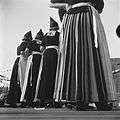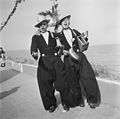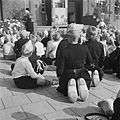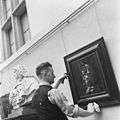Emmy Andriesse
Emmy Eugenie Andriesse (14 January 1914 in The Hague – 20 February 1953 in Amsterdam) was a Dutch photographer best known for her work with the Underground Camera group (De Ondergedoken Camera) during World War II.[2]
Emmy Andriesse | |
|---|---|
| Born | Emmy Eugenie Andriesse 14 January 1914 The Hague, Netherlands |
| Died | 20 February 1953 (aged 39) Amsterdam, Netherlands |
| Nationality | Dutch |
| Occupation | Photographer |
| Known for | De Ondergedoken Camera[1] |
| Spouse(s) | Dick Elffers |
Early life and education
Emmy Andriesse was the only child of liberal Jews Abraham Andriesse and Else Fuld, both working in textile companies. At age fifteen, she lost her mother, and since her father traveled internationally for work, she was raised by several aunts.[2]
From 1932 to 1937, after high school, Andriesse studied advertising design at the Academy of Fine Arts in The Hague founded in 1929 by designer Gerrit Kiljan. At the academy she belonged to a group of students around left-wing designer Paul Schuitema. She attended an experimental class taught by Paul Schuitema and Gerrit Kiljan, where she learnt photography and the use of photographs in posters, advertising and newspaper articles.[3] In her final years of study, she lived in Voorburg in a 'community house' together with a group of politically conscious fellow students. Amongst the 15 or so residents were photographer Hans Wolf and academics Eva Loeb, Hans Ijzerman and Lex Metz.[4] In this environment Andriesse and her friends came into contact with International Red Aid and various anti-fascist artists' organizations.[2]
War years and the 'Underground Camera'
In June 1941 Andriesse married graphic designer and visual artist Dick Elffers (a gentile with whom she had two sons, one who died young), but as a Jew during the Nazi occupation Andriesse was no longer able to publish and she was forced into hiding. At the end of 1944, with the assistance of the anthropologist Arie de Froe she forged an identity card and re-engaged in everyday life, joining a group of photographers, including Cas Oorthuys and Charles Breijer, working clandestinely as De Ondergedoken Camera.[2] The photos that Andriesse made under very difficult conditions of famine in Amsterdam, include Boy with pan, The Gravedigger and Kattenburg Children are documents of hunger, poverty and misery during the occupation in the "winter of hunger" of 1944-1945.[1]
 Volendam July 1945
Volendam July 1945

 The Love Letter (Vermeer)
The Love Letter (Vermeer)
(Rijksmuseum July 1945) The Anatomy Lesson of Dr. Deijman back in the Rijksmuseum
The Anatomy Lesson of Dr. Deijman back in the Rijksmuseum
(July 1945)
Post-war
After the war, she became a fashion photographer and was an associate and mentor of Ed van der Elsken. She participated in the group show Photo '48 and in 1952, together with Carel Blazer, Eva Besnyö and Cas Oorthuys, the exhibition Photographie, both in Amsterdam's Stedelijk Museum.[2] Edward Steichen chose her 1947 portrait of a staid and elderly Dutch couple for the section 'we two form a multitude'[5] in the Museum of Modern Art world-touring The Family of Man that was seen by an audience of 9 million.[6] [7] More recently (October 2006-January 2007) she was included in a display of Twentieth Century European photography at the Barbican Art Gallery, London.[1]
Andriesse's last commission, the book The World of Van Gogh - published posthumously in 1953 - was not yet complete when she became ill and after a long battle with cancer, died at the age of 39.[2]
At Harbor Island East in Amsterdam, the Emmy Andriessestraat is named after him.
References
- Rawsthorn, Alice (October 17, 2006). "A secret history: A new exhibition of Emmy Andriesse's work". The Guardian. Retrieved October 28, 2017.
- Visser, Hripsimé (2013). "Andriesse, Emmy Eugenie (1914-1953)". Biographical Dictionary of the Netherlands. Huygens ING - The Hague.
- "EMMY ANDRIESSE (1914-1953)". 19 December 2013. Retrieved 15 November 2016.
- "Andriesse, Emmy Eugenie". Joods Historisch Museum, Amsterdam (Jewish Historical Museum). Archived from the original on December 28, 2010. Retrieved October 28, 2017.
- Sandeen, Eric J (1995), Picturing an exhibition : the family of man and 1950s America (1st ed.), University of New Mexico Press, p. 121, ISBN 978-0-8263-1558-8
- Steichen, Edward; Steichen, Edward, 1879-1973, (organizer.); Sandburg, Carl, 1878-1967, (writer of foreword.); Norman, Dorothy, 1905-1997, (writer of added text.); Lionni, Leo, 1910-1999, (book designer.); Mason, Jerry, (editor.); Stoller, Ezra, (photographer.); Museum of Modern Art (New York, N.Y.) (1955). The family of man : the photographic exhibition. Published for the Museum of Modern Art by Simon and Schuster in collaboration with the Maco Magazine Corporation.CS1 maint: multiple names: authors list (link) CS1 maint: extra text: authors list (link)
- "The Family of Man". The Museum of Modern Art. Retrieved 2019-02-05.
- Visser, Hripsime and Bool, Flip (1994). Emmy Andriesse (1914-1953). Focus Publishing, Amsterdam.
- *Bool, Flip (1994). Emmy Andriesse : 1914-1953. Amsterdam: Focus. ISBN 9072216903. OCLC 632879111.,Louise (1975) Emmy Andriesse - a profile in Emmy Andriesse Photographs 1944/52 (Exhibition catalogue) Rijksmuseum, Amsterdam
- Visser, Hripsimé (1984), essay in History of Dutch photography Alphen aan den Rijn
- 30 April 1991 NOS broadcast television documentary Emmy Andriesse
- Baring, Louise (2013). "Emmy Andriesse - Hidden Lens". Schilt Publishing, Amsterdam.
Further reading
- Bool, Flip (1994). Emmy Andriesse : 1914-1953. Amsterdam: Focus. ISBN 9072216903. OCLC 632879111.
- Baring, Louise (2013). Emmy Andriesse - Hidden Lens. London: Thames and Hudson. ISBN 9789053307908. OCLC 900301980.
- Rosenblum, Naomi (2014). A history of women photographers (3rd ed.). New York : Abbeville. ISBN 9780789212245.
External links
| Wikimedia Commons has media related to Emmy Andriesse. |
- Biography (Dutch)
- Photobook with biography (English)